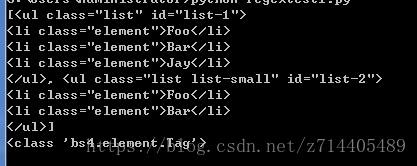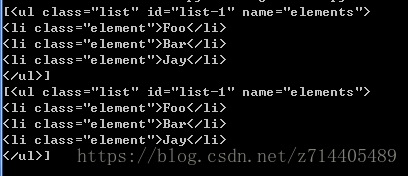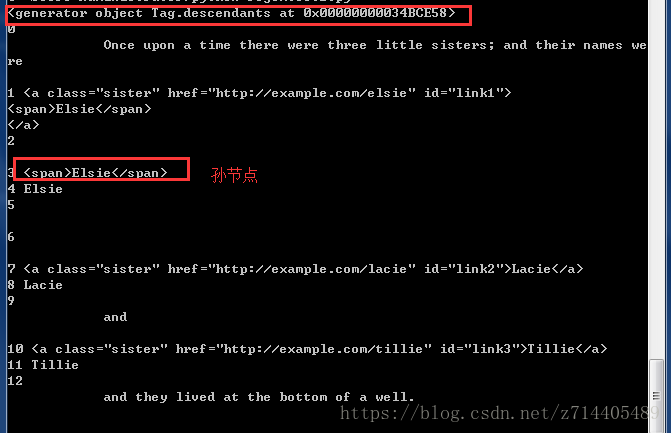BeautifulSoup库使用详解
BeautifulSoup库是灵活又方便的网页解析库,处理高效,支持多种解析器。利用它不用编写正则表达式即可方便地实现网页信息的提取。
安装:pip3 install beautifulsoup4
解析库
| 解析器 | 使用方法 | 优势 | 劣势 |
| Python标准库 | BeautifulSoup(markup, “html.parser”) | Python的内置标准库、执行速度适中 、文档容错能力强 | Python 2.7.3 or 3.2.2)前的版本中文容错能力差 |
| lxml HTML 解析器 | BeautifulSoup(markup, “lxml”) | 速度快、文档容错能力强 | 需要安装C语言库 |
| lxml XML 解析器 | BeautifulSoup(markup, “xml”) | 速度快、唯一支持XML的解析器 | 需要安装C语言库 |
| html5lib | BeautifulSoup(markup, “html5lib”) | 最好的容错性、以浏览器的方式解析文档、生成HTML5格式的文档 | 速度慢、不依赖外部扩展 |
基本使用
html = """
The Dormouse's story
The Dormouse's story
Once upon a time there were three little sisters; and their names were
,
Lacie and
Tillie;
and they lived at the bottom of a well.
...
"""
from bs4 import BeautifulSoup
soup = BeautifulSoup(html, 'lxml')#传入解析器:lxml
print(soup.prettify())#格式化代码,自动补全
print(soup.title.string)#得到title标签里的内容
标签选择器
选择元素
html = """
The Dormouse's story
The Dormouse's story
Once upon a time there were three little sisters; and their names were
,
Lacie and
Tillie;
and they lived at the bottom of a well.
...
"""
from bs4 import BeautifulSoup
soup = BeautifulSoup(html, 'lxml')#传入解析器:lxml
print(soup.title)#选择了title标签
print(type(soup.title))#查看类型
print(soup.head)
获取名称
from bs4 import BeautifulSoup
soup = BeautifulSoup(html, 'lxml')#传入解析器:lxml
print(soup.title.name)
也就是获得了标签的名称。
![]()
获取属性
from bs4 import BeautifulSoup
soup = BeautifulSoup(html, 'lxml')#传入解析器:lxml
print(soup.p.attrs['name'])#获取p标签中,name这个属性的值
print(soup.p['name'])#另一种写法,比较直接
获取内容
print(soup.p.string)
嵌套选择
from bs4 import BeautifulSoup
soup = BeautifulSoup(html, 'lxml')#传入解析器:lxml
print(soup.head.title.string)
![]()
子节点和子孙节点
html = """
The Dormouse's story
Once upon a time there were three little sisters; and their names were
Elsie
Lacie
and
Tillie
and they lived at the bottom of a well.
...
"""
from bs4 import BeautifulSoup
soup = BeautifulSoup(html, 'lxml')#传入解析器:lxml
print(soup.p.contents)#获取指定标签的子节点,类型是list
from bs4 import BeautifulSoup
soup = BeautifulSoup(html, 'lxml')#传入解析器:lxml
print(soup.p.children)#获取指定标签的子节点的迭代器对象
for i,children in enumerate(soup.p.children):#i接受索引,children接受内容
print(i,children)
输出结果与上面的一样,多了一个索引。注意,只能用循环来迭代出子节点的信息。因为直接返回的只是一个迭代器对象。

获取子孙节点:
from bs4 import BeautifulSoup
soup = BeautifulSoup(html, 'lxml')#传入解析器:lxml
print(soup.p.descendants)#获取指定标签的子孙节点的迭代器对象
for i,child in enumerate(soup.p.descendants):#i接受索引,child接受内容
print(i,child)
父节点和祖先节点
parent
from bs4 import BeautifulSoup
soup = BeautifulSoup(html, 'lxml')#传入解析器:lxml
print(soup.a.parent)#获取指定标签的父节点
parents
from bs4 import BeautifulSoup
soup = BeautifulSoup(html, 'lxml')#传入解析器:lxml
print(list(enumerate(soup.a.parents)))#获取指定标签的祖先节点
##兄弟节点
from bs4 import BeautifulSoup
soup = BeautifulSoup(html, 'lxml')#传入解析器:lxml
print(list(enumerate(soup.a.next_siblings)))#获取指定标签的后面的兄弟节点
print(list(enumerate(soup.a.previous_siblings)))#获取指定标签的前面的兄弟节点
标准选择器
find_all( name , attrs , recursive , text , **kwargs )
可根据标签名、属性、内容查找文档。
name
html='''
Hello
- Foo
- Bar
- Jay
- Foo
- Bar
'''
from bs4 import BeautifulSoup
soup = BeautifulSoup(html, 'lxml')
print(soup.find_all('ul'))#查找所有ul标签下的内容
print(type(soup.find_all('ul')[0]))#查看其类型

看看如何嵌套地查找标签下的子标签吧~
下面的例子就是查找所有ul标签下的li标签:
from bs4 import BeautifulSoup
soup = BeautifulSoup(html, 'lxml')
for ul in soup.find_all('ul'):
print(ul.find_all('li'))
attrs
(属性)
通过属性进行元素的查找:
html='''
Hello
- Foo
- Bar
- Jay
- Foo
- Bar
'''
from bs4 import BeautifulSoup
soup = BeautifulSoup(html, 'lxml')
print(soup.find_all(attrs={'id': 'list-1'}))#传入的是一个字典类型,也就是想要查找的属性
print(soup.find_all(attrs={'name': 'elements'}))

查找到的是同样的内容,因为这两个属性是在同一个标签里面的。
特殊类型的参数查找:
from bs4 import BeautifulSoup
soup = BeautifulSoup(html, 'lxml')
print(soup.find_all(id='list-1'))#id是个特殊的属性,可以直接使用
print(soup.find_all(class_='element')) #class是关键字所以要用class_
text
根据文本内容来进行选择:
html='''
Hello
- Foo
- Bar
- Jay
- Foo
- Bar
'''
from bs4 import BeautifulSoup
soup = BeautifulSoup(html, 'lxml')
print(soup.find_all(text='Foo'))#查找文本为Foo的内容,但是返回的不是标签
![]()
所以说这个text在做内容匹配的时候比较方便,但是在做内容查找的时候并不是太方便。
方法
find
find用法和findall一模一样,但是返回的是找到的第一个符合条件的内容输出。
find_parents(), find_parent()
find_parents()返回所有祖先节点,find_parent()返回直接父节点。
find_next_siblings() ,find_next_sibling()
1返回后面的所有兄弟节点,2返回后面的第一个兄弟节点
find_previous_siblings(),find_previous_sibling()
1返回前面所有兄弟节点…
find_all_next(),find_next()
1返回节点后所有符合条件的节点,2返回后面第一个符合条件的节点
find_all_previous()和find_previous()
同理。
CSS选择器
通过select()直接传入CSS选择器即可完成选择
html='''
Hello
- Foo
- Bar
- Jay
- Foo
- Bar
'''
from bs4 import BeautifulSoup
soup = BeautifulSoup(html, 'lxml')
print(soup.select('.panel .panel-heading'))#.代表class,中间需要空格来分隔
print(soup.select('ul li')) #选择ul标签下面的li标签
print(soup.select('#list-2 .element')) #'#'代表id。这句的意思是查找id为"list-2"的标签下的,class=element的元素
print(type(soup.select('ul')[0]))#打印节点类型
再看看层层嵌套的选择:
from bs4 import BeautifulSoup
soup = BeautifulSoup(html, 'lxml')
for ul in soup.select('ul'):
print(ul.select('li'))
把每个ul标签中的li标签输出:
获取属性
from bs4 import BeautifulSoup
soup = BeautifulSoup(html, 'lxml')
for ul in soup.select('ul'):
print(ul['id'])# 用[ ]即可获取属性
print(ul.attrs['id'])#另一种写法
获取内容
from bs4 import BeautifulSoup
soup = BeautifulSoup(html, 'lxml')
for li in soup.select('li'):
print(li.get_text())
总结
- 推荐使用lxml解析库,必要时使用html.parser
- 标签选择筛选功能弱但是速度快
- 建议使用find()、find_all() 查询匹配单个结果或者多个结果
- 如果对CSS选择器熟悉建议使用select()
- 记住常用的获取属性和文本值的方法









